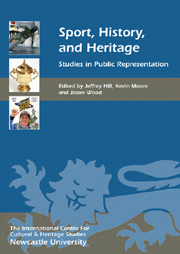Book contents
- Frontmatter
- Contents
- List of Illustrations
- Acknowledgments
- Sport, History and Heritage: An Investigation into the Public Representation of Sport – Editors' General Introduction
- HISTORY, HERITAGE AND SPORT
- MUSEUMS AND THE REPRESENTATION OF SPORT
- SURVIVALS AND LEGACIES: SPORT, HERITAGE AND IDENTITY
- 12 Survivals and Legacies: Sport, Heritage and Identity
- 13 Anfield: Relocating Liverpool's Spiritual Home
- 14 The Canonisation of Common People: Memorialisation and Commemoration in Football
- 15 Heritage, Culture and Identity: The Case of Gaelic Games
- 16 Olympic Heritage – An International Legacy: The Invention of the Modern Olympic Stadium from Coubertin to 1948
- 17 The Indianapolis 500: Making the Pilgrimage to the ‘Yard of Bricks’
- Afterword: History and Heritage in Sport
- List of Contributors
- Index
- HERITAGE MATTERS
13 - Anfield: Relocating Liverpool's Spiritual Home
from SURVIVALS AND LEGACIES: SPORT, HERITAGE AND IDENTITY
Published online by Cambridge University Press: 05 April 2013
- Frontmatter
- Contents
- List of Illustrations
- Acknowledgments
- Sport, History and Heritage: An Investigation into the Public Representation of Sport – Editors' General Introduction
- HISTORY, HERITAGE AND SPORT
- MUSEUMS AND THE REPRESENTATION OF SPORT
- SURVIVALS AND LEGACIES: SPORT, HERITAGE AND IDENTITY
- 12 Survivals and Legacies: Sport, Heritage and Identity
- 13 Anfield: Relocating Liverpool's Spiritual Home
- 14 The Canonisation of Common People: Memorialisation and Commemoration in Football
- 15 Heritage, Culture and Identity: The Case of Gaelic Games
- 16 Olympic Heritage – An International Legacy: The Invention of the Modern Olympic Stadium from Coubertin to 1948
- 17 The Indianapolis 500: Making the Pilgrimage to the ‘Yard of Bricks’
- Afterword: History and Heritage in Sport
- List of Contributors
- Index
- HERITAGE MATTERS
Summary
Anfield, home to Liverpool Football Club since 1892, is no ordinary sports venue. The stadium is synonymous with Liverpool and a powerful repository of the history and heritage of ‘England's most successful football club’. This chapter explores that legacy in light of the club's wish to create a new home, either by rebuilding Anfield or relocating to a completely new stadium. Such are the passion and pride of the fans and the local community, and such are the profundity and resonance of the implications throughout the district, the city and across the football world, that this move is something the club is committed to getting right.
STANLEY PARK AND THE GENESIS OF ANFIELD
The remarkable history of Liverpool FC and its Anfield stadium are woven into the fabric of the surrounding area, in particular that of Stanley Park. Opened in 1870, and explicitly dedicated to the recreation of working people, the park's grounds were landscaped by Edward Kemp (1817–1891) and the buildings designed by Borough Surveyor E R Robson (1835–1917) (Layton-Jones and Lee 2008). One year later, only a short walk from Stanley Park, the first services were held at the newly constructed St Domingo Methodist Chapel (now demolished), located at the junction between Breckfield Road North and St Domingo Vale in Everton.
- Type
- Chapter
- Information
- Sport, History, and HeritageStudies in Public Representation, pp. 195 - 210Publisher: Boydell & BrewerPrint publication year: 2012



